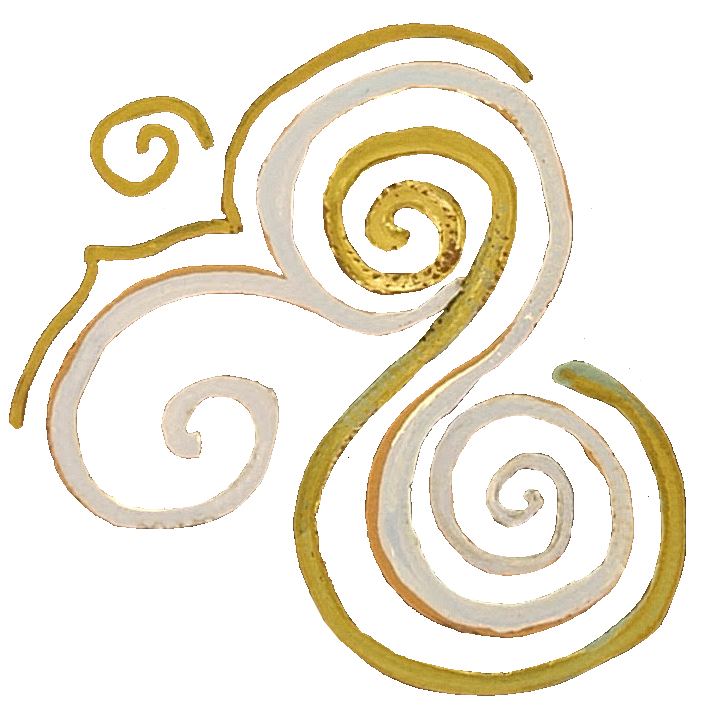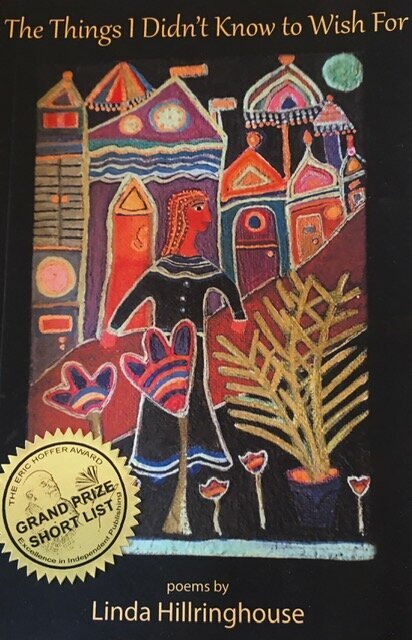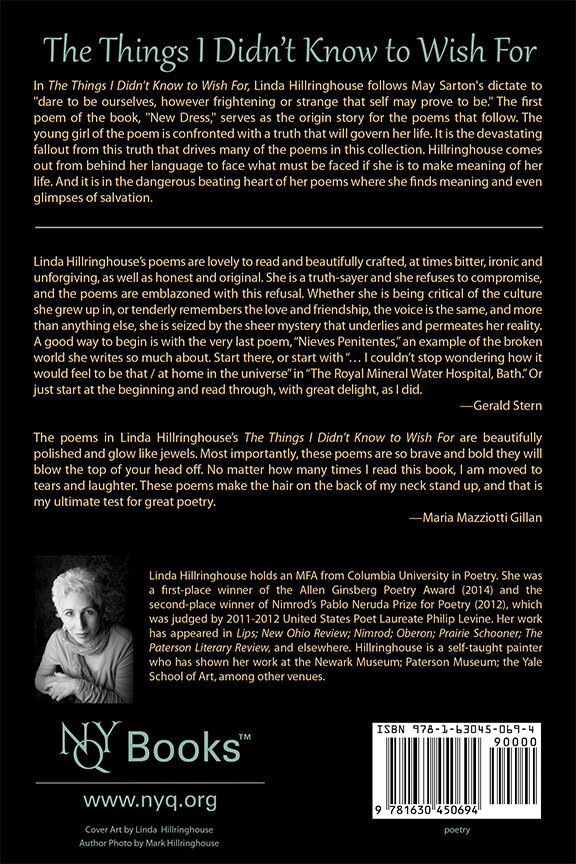Artist Statement
I come out of a folk tradition, as I am self-taught.
My work contains a theatrical/psychological motif: the feeling that something happened, is trying to happen, or will happen – externally or internally -- or in a dream.
Biography
Linda Hillringhouse is a self-taught painter who has shown her work at the Newark Museum, Newark, NJ; Paterson Museum, Paterson NJ; University Galleries at the Ben Shan Center for the Visual Arts, William Paterson University, Wayne; Belskie Museum, Closter, NJ; Sandy Bennett Gallery at the Bergen Performing Arts Center, Englewood, NJ; Yale School of Art, New Haven, CT, among other venues.
The Things I Didn’t Know to Wish For
In The Things I Didn’t Know to Wish For, Linda Hillringhouse follows May Sarton’s dictate to “dare to be ourselves, however frightening or strange that self may prove to be.“
Disguised in Dreams
Art Exhibit at Farleigh Dickinson University
Interview with Linda Hillringhouse
Artist Statement
I come out of a folk tradition, as I am self-taught.
My work contains a theatrical/psychological motif: the feeling that something happened, is trying to happen, or will happen – externally or internally -- or in a dream.
The figures display themselves in imaginary landscapes or interiors. They appear to be self-conscious actors who know something the artist doesn’t. They reflect surprise, a kind of gawky bemusement, and, perhaps, a touch of dread at finding themselves painted into existence.
They seem to struggle to become fully conscious and to feel at home in their bodies and in their surroundings. They seem stunned by the miraculous visible world but somehow know they are bound to the invisible world. My paintings seem to occur on the border between these realms.
Biography
Linda Hillringhouse is a self-taught painter who has shown her work at the Newark Museum, Newark, NJ; Paterson Museum, Paterson NJ; University Galleries at the Ben Shan Center for the Visual Arts, William Paterson University, Wayne; Belskie Museum, Closter, NJ; Sandy Bennett Gallery at the Bergen Performing Arts Center, Englewood, NJ; Yale School of Art, New Haven, CT, among other venues. Her work is included in the Hamilton Club Art Collection, Paterson, NJ. She was selected for inclusion in the 20th Century Self-Taught Artists Archive Collection at The Museum of American Folk Art, NY, NY. Hillringhouse holds an MFA from Columbia University in Poetry. She was a first-place winner of the Allen Ginsberg Poetry Award (2014) and the second-place winner of Nimrod’s Pablo Neruda Prize for Poetry (2012). Her work has appeared in Lips; New Ohio Review; Oberon; Prairie Schooner; The Paterson Literary Review, and elsewhere. Her book of poetry, The Things I Didn’t Know to Wish For, was published by New York Quarterly Press in May 2020 —- and longlisted as a finalist for the Julie Suk Award (2020) and shortlisted for The Eric Hoffer Book Award Grand Prize (2021).
The Things I Didn’t Know to Wish For
The Things I Didn’t Know to Wish For can be purchased here:
https://www.nyq.org/books/title/the-things-i-didnt-know-to-wish-for
Disguised in Dreams
Exhibit at Fairleigh Dickinson University
Interview with Linda Hillringhouse
Tell me about your educational background, and how that has contributed to your artistic development. For example, your Master's degree in Poetry and your teaching experience.
I have a B.A. in English from Goddard College, a small liberal arts college in Vermont and an M.F.A. (Master’s of Fine Arts) in Poetry from Columbia University in New York City. As an undergraduate English major, I read a lot. When you read works of the imagination, your own imagination is fed. What happens between you and the story or poem or play is mystical in the sense that you enter another world, live there for a while, and leave, but not as the same person you were. You know more about the way people think and feel (including yourself) and more about the world. But you don't just "know" more, what you "lived" as you read becomes part of you forever. Also, I think the “picturing” that takes place as you read “trains” the imagination “to picture” on its own. Reading helped bring me to poetry and painting.
It was very exciting (and scary) to be writing poetry in the M.F.A. program at Columbia University in the 1970’s. My writing instructors were Mark Strand and Stanley Kunitz, both of whom were compassionate and penetrating critics. My poetry was very imagistic; I was in love with images. When I wrote poetry, image and feeling seemed to arrive at the same time – followed by thought. When I paint, it’s a purely visual experience composed of images. I am not aware of feeling or thought. In fact, I feel completely “empty” as I work, as if just my arm, hand, and paintbrush were “alive.” Maybe painting was the easy way out for me. It’s so much easier than writing. Writing poetry requires you to go deep inside yourself in search of the poem, to the places where you are most honest and most alive; sometimes you go to places you wish you hadn’t. And then you have to use the “smartest” part of your mind to pull together all the “stuff” you’ve brought back with you and craft it into a poem.
Teaching writing at Passaic County Community College {Paterson, NJ} also influenced my artistic life in the sense that I had a kind of privileged access to the inner lives of so many students through their writing and through their responses to the literature we read. Although reading is initially a private act, entering a text with other people can make it come to life in new ways since it is being filtered through so many different sensibilities and experiences. In addition, exposure to so many different cultures at PCCC definitely fed my imagination and influenced my art.
You are a "self-taught painter." What criteria are necessary in order for an artist to be considered "self-taught.” For example, would an artist without a formal art training/education be considered self-taught?
A self-taught artist is without formal art training or art education. I always loved looking at paintings and just started to “play” with watercolors when I was in my 20’s. At that time, I outlined everything in black, almost like a coloring book. It must’ve given me a sense of security. Gradually, I stopped outlining, but I remember the “free fall” feeling when I no longer had the dark lines to “control” the color and composition.
What makes this exhibit unique when compared to others?
This show has two pieces, which are not representative of my work and may represent new directions for me. One piece is “Mermaid with Toy Moon”: it is acrylic with an added texture medium on canvas and I painted the frame. I usually work on paper and generally don’t paint the frame as “part” of the painting. The other piece is “Empty Street with Figure”: it has some cubistic elements, which came as a surprise to me. I see in this painting possibly a bridge between a highly decorative style and a “cleaner” style, which, for me, represents the courage of open space in a painting.
What other artists and art works are you a fan of?
There is so much art that I love, it’s hard to know where to begin. I love prehistoric art; ancient art (especially Mesopotamian, Minoan and Etruscan); Islamic; Medieval; Asian (Indonesian in particular); African; Pre-Colombian; Impressionism; Outsider Art, etc. Actually, the only art I can think of that doesn’t excite me is 18th century European and North American art. The first painting I can remember seeing as a kid is Henri Rousseau’s Sleeping Gypsy at the Museum of Modern Art in New York City. It stopped me in my tracks – and still does whenever I see it.
The most recent solo show that “stopped me in my tracks” featured the work of an “outsider” artist named Martin Ramirez at the Museum of American Folk Art in New York City. He was an immigrant from Mexico who crossed the border (in the 1930’s, I believe) into California looking for work to support the family he left behind. He ended up homeless and then in California mental hospitals where he spent over 30 years of his life. He never spoke more than a few words during that time. But he created art using whatever was available, crayons, matchsticks, doctors’ examining table paper, etc. I cried when I saw his work. I felt I was standing in sacred space inside a cathedral Ramirez had built out of the rich language of his silence.
You were selected in the "20th Century Self-Taught Artists" collection at the Museum of American Folk Art in New York. As an artist, how does this make you feel?
Actually, I am in the archive collection at the Museum of American Folk Art, which means the images of my work are recorded as part of the museum’s research on self-taught artists.
Do you schedule a day and time to paint? Or is your creative process more spontaneous? For example, it happens when you feel a surge of creativity.
When I was teaching, I could only paint on the breaks. But now that I’m retired, I’m trying to paint as much as possible, while still leaving time to write.
Your paintings are very unique and colorful. Where does your inspiration come from? What inspires you to create art?
It’s very hard to pin down the source of inspiration. All I know is that certain combinations of color and light and form that I see in the world and in art make me ecstatic.
Fairleigh Dickinson University is currently exhibiting a collection of your work titled "Disguised in Dreams.” What is the meaning of the title? What message does the title "Disguised in Dreams" convey about this particular collection?
The title “Disguised in Dreams” just popped into my head (usually, it takes me days to come up with a title). But it may refer to the unknown source and meaning of my paintings. The figures seem to be wearing disguises that originate in a dream-like place. Even the interiors and landscapes seem to be in disguise. My paintings just seem to mysteriously appear to me – I don’t plan them. Maybe that has something to do with the title.
Let's discuss one of the paintings from this collection. "Studio with Five Moons" is very imaginative. Overall, what are you telling us through this painting? Is there an overall message? Why five moons? Why is the setting an art studio?
Many of my paintings feature a moon. The sun has a friendly familiar feel – we bask in the sun; it makes flowers grow; and in the sunlight we can see our world and feel safe. The moon, on the other hand, despite its “romantic reputation,” feels alien to me and makes me more aware of my status as a creature living on a sphere that spins in an unknowable universe for an unknowable reason. Maybe the moon is a symbol of my ignorance. I’m here on earth without a clue. Sometimes this ignorance is exhilarating; sometimes it’s terrifying. The moon can sometimes feel like a watching eye. The feeling I get from “Studio with Five Moons” is not so much that the moons are looking into the studio, but that they are outside the studio and can never let the artist forget that there’s strangeness and mystery everywhere and that she doesn’t have access to the truth. The artist is absent from the studio in this painting. The subject of the canvas on the easel has her “back” to the moons. Maybe the artist has painted herself onto the canvas and out of existence. I’m clueless!
The "Disguised in Dreams" collection features seventeen paintings. Is there one particular painting, in this collection, that you would consider your favorite? If so, which one and why?
Probably Family Wading in River (although Mermaid with Toy Moon is a close second). I like the mysterious rite the family in Family Wading in River seems to be performing, maybe a kind of midnight baptism. I also like the implied journey down through the dark woods they would’ve taken to get to the water from the town above.
Most of your paintings introduce us to figures or characters, for example, the painting "Vacation.” Are the paintings a reflection of you, are they autobiographical? Do you portray your personal experiences in the paintings? For example, "Couple with Child,” is that a family portrait?
My paintings are generally not autobiographical in the sense that they reflect actual experiences I’ve had – although in this show Vacation was inspired by a vacation in the Adirondack Mountains. Also, Studio is based on an actual studio I had in East Orange, NJ many years ago. Maybe my paintings are an autobiography of my “second self,” the unconscious one.
Can you define for us, in layman's terms, what the following art words mean? Gouache, acrylic, watercolor and batik.
Gouache is opaque color (you can’t see through it) in a tube that is mixed with water. Acrylic paint is in a tube and can be mixed with water while the paint is wet. But once the paint dries, it is permanent (but it can be painted over). Acrylic is similar to oil, but it’s a cleaner, quicker-drying medium (unfortunately, it doesn’t have the richness and sheen of oil). Watercolor is color in tubes or cubes that can achieve transparency with water. Batik is the Indonesian technique of using wax to coat the parts of fabric or paper you don’t want to be covered with dye. I use rice paper, wax, and dye to create a painting. I then paint over some of the dye, which is not part of traditional batik. (“Batik” is the name of the process and the product.)
This question might be somewhat constraining. But if you were to describe in one word, The "Disguised in Dreams" collection, what word would you use?
I tried, but I just couldn’t come up with one word. The FDU press release used the words “vibrant” and “imaginative” to describe the show. Here are some other words and phrases that have been used to describe my work: mysterious, whimsical, primitive but sophisticated, witty, complex.
What advice would you give to struggling artists who are trying to get their work exhibited?
Although I’m sure that I’ll always consider myself a struggling artist, I have learned some lessons along the way:
*look for the courage to be alone to do the work
*don’t be afraid of what you bring forth (I have a quotation over my work table by May Sarton: “We have to dare to be ourselves, however frightening or strange that self may prove to be.”)
*be willing to sacrifice to do the work
*learn to control distractions (saying no is hard)
*don’t fear rejection; just keep working
*don’t squander your time and energy
*keep accurate digital and hard copy records of your work
*when the time is right to get your work “out there,” be prepared to accept rejection (it hurts, but eventually you’ll find the right venue)
2007






